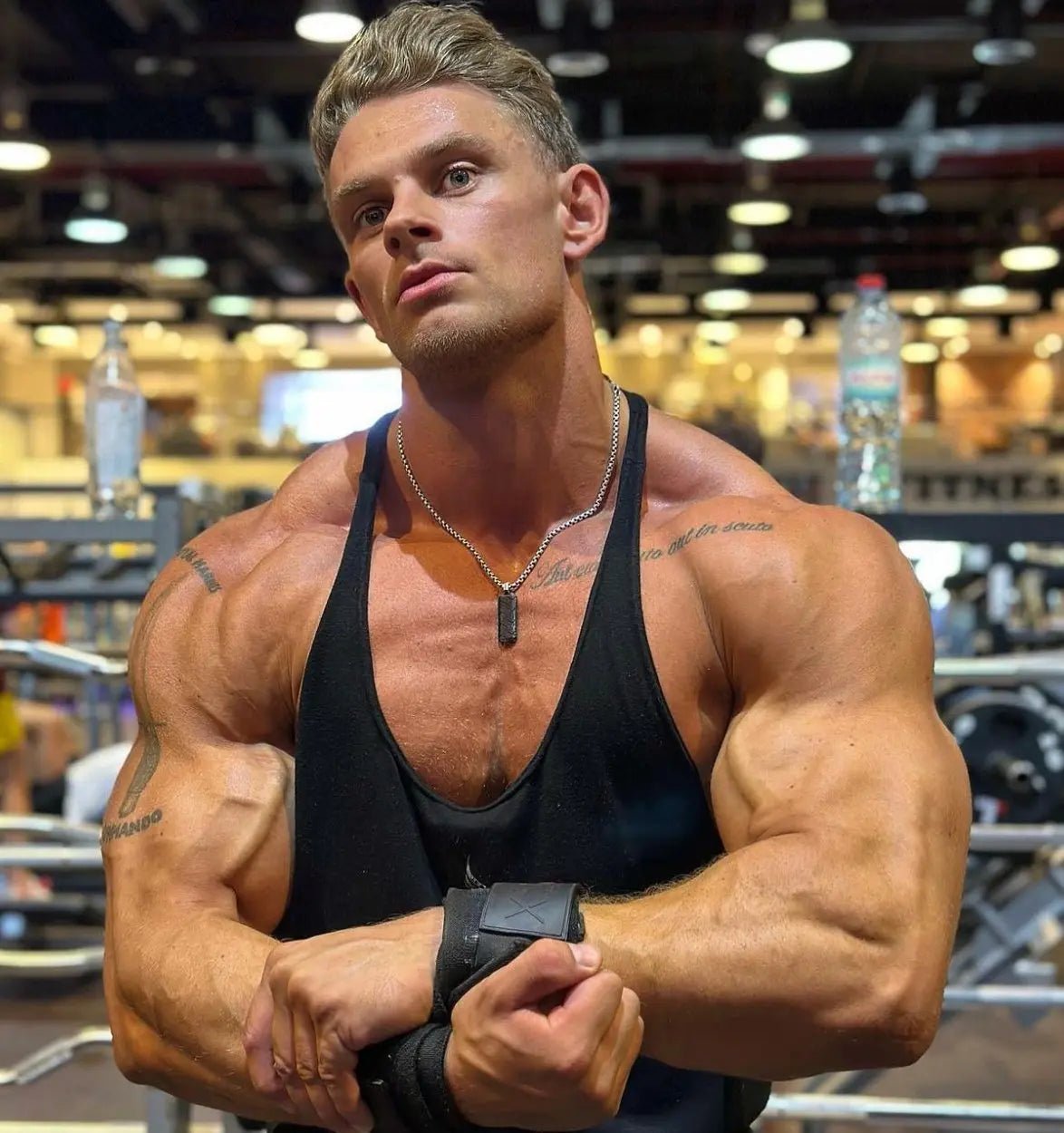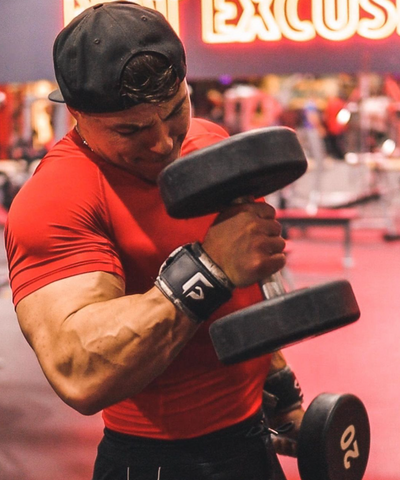
Forearm Dumbbell Workout 101: Best Forearm Exercises
Looking to build those Popeye bulging pipes? Maybe the barbell or bodyweight exercises aren't cutting it anymore, in this article we'll cover how to integrate dumbbells into fitness routine. Strong forearms not only improve grip strength but also enhance the overall aesthetic appearance of the arms. They are involved in almost every upper body movement, making it important to train them effectively.
There are a variety of exercises that can be performed with dumbbells that are great for building your forearm muscles and can be easily integrated into your home workouts, let's dive in.
Understanding Forearm Anatomy
The muscles between the elbow and wrist, and they are responsible for controlling the movement of the wrist, hand, and fingers. The forearm muscles consist of two bones, the radius and ulna, and twenty muscles that control the movement of the wrist, hand, and fingers.
The following are some of the major muscles:
- Brachioradialis: This muscle is located on the outer side and helps in flexing the elbow.
- Extensor digitorum: This muscle is located on the back and helps in extending the fingers.
- Flexor carpi radialis: This muscle is located on the inner side and helps in flexing the wrist.
- Pronator teres: This muscle is located on the inner side and helps in pronating the forearm.
- Palmaris longus: This muscle is located on the inner side and helps in flexing the wrist.
- Flexor digitorum superficialis: This muscle is located on the inner side and helps in flexing the fingers.
- Flexor carpi ulnaris: This muscle is located on the inner side and helps in flexing the wrist.
It is important to understand the anatomy to effectively target and train the muscles. A balanced workout should include exercises that target all the major muscles of the forearm.

The Importance of Forearm Strength in Weight Training
Forearm strength is important for overall strength and performance in daily activities and sports. They play a crucial role in grip strength, which is essential for carrying heavy objects, performing exercises like deadlifts and pull-ups, and maintaining proper posture.
Having strong forearms can also improve endurance and balance, as it allows for better control and stability during physical activities. In addition, strong forearms can prevent injuries by reducing the risk of strains and sprains in the wrists and hands.
For athletes, forearm strength is particularly important in sports that involve gripping, such as rock climbing, tennis, and golf. Strong forearms can improve grip strength, which can lead to better performance and reduced risk of injury.
Incorporating forearm exercises into a routine can help improve overall strength and prevent muscle imbalances. Exercises with dummbells, in particular, can be effective for targeting the forearms and improving grip strength.
Choosing the Right Dumbbells For Forearm Muscles
When it comes to dumbbell workouts, choosing the right ones is crucial. Here are a few things to keep in mind when selecting the right equipment for your workout:
Weight
The weight of the dumbbells you choose will depend on your fitness level and goals. For beginners, it's recommended to start with lighter weights and gradually work your way up. A good starting point is between 5-10 pounds. For more advanced lifters, heavier weights may be necessary for a more challenging workout.
Grip
The grip of the dumbbell is also an important factor to consider. A neutral grip, where the
Adjustable vs Fixed-Weight Dumbbells
Adjustable dumbbells allow for easy weight adjustments and take up less space, making them a popular choice for home gyms. However, fixed-weight dumbbells are more durable and provide a more consistent weight distribution, making them a good option for commercial gyms.
Dumbbell Forearm Workouts
Essential for anyone looking to build a strong and balanced upper. While exercises like deadlifts, pullups, and curls can work them to some extent, specific training is required to develop them fully.
Using dumbells are a great way to target the specific muscles, the exercises listed below will help to effectively target the muscles in the forearm.
Incorporating these exercises can help you strengthen your grip and build those forearms. It is recommended to perform 3-4 sets of 10-12 reps of each exercise, with a weight that allows you to perform the exercise with proper form. It is also important to gradually increase the weight as your strength improves.
Best Dumbbell Forearm Exercises - Hammer Curl & Wrist Curl
There are a variety of methods that can help. Here are some of the best forearm exercises that can be performed with dumbbells, they can also be integrated as part of your bicep workout:
Curl Exercises
One of the best exercises for this is the dumbbell wrist curl. To perform this exercise, sit on a bench and hold a dumbbell in one hand, palm up, and allow your elbow and forearm to rest on your thigh. With your hand dangling off your knee, curl your wrist so your
Neutral wrist curls are another great exercise. Sit on a bench with a dumbbell in each hand,
Hammer Curl Exercises
Another effective exercise is the hammer curl. To perform this exercise, grab a pair of dumbbells, hold one in each hand with your

Wrist Curl Exercises
A great forearm exercise specifically designed to target the wrist flexor and extensor muscles. These muscles are responsible for wrist and finger movement, making them essential for grip strength. Some popular wrist curl exercises include the reverse wrist curl, palms-down wrist curl, overhand grip curl and wrist rotation. By performing these exercises with dumbbells, the resistance can be adjusted to suit individual strength levels.
Row and Pull-Up Exercises
Row and pull-up exercises are great for building overall upper body strength. These exercises involve pulling the weight towards the body, which engages the biceps and forearms. Some popular row and pull-up exercises that can be performed with dumbbells include the bent-over row, single-arm row, and farmer’s carry.
Thick Bar Training
Using a thicker bar or fat grip accessories like Grenadier Grips equals greater muscle activation. If your gym doesn't have thick bars, attaching these grips means there's much more focus on the forearms. They are a great addition to your gym bag.
Other Exercises
In addition to the exercises mentioned above, there are a variety of other exercises that can help.. These include finger curls, concentration curls, and deadlifts. Finger curls involve gripping the weight and curling the fingers towards the palm, while concentration curls involve curling the weight with one arm while the other arm supports the weight. Deadlifts are a compound exercise that work multiple muscle groups, including the forearms.
Dumbbell Workout Structure and Repetition
Workout structure and repetition are crucial factors to consider. The goal is to create a workout routine that targets the muscle groups while also avoiding over-fatigue and exhaustion.
To achieve this, it is recommended to perform 3-4 sets of each exercise with 10-15 reps per set. This repetition range is ideal for building muscle endurance and strength without causing excessive fatigue. However, it is important to note that the number of sets and repetitions may vary based on individual fitness goals and abilities.
Benefits for Bodybuilders and Lifters
Here are some of the advantages for those who are trying to build muscle mass, improve their aesthetic, and develop a better physique.
Improved Grip Strength
Forearm exercises using dumbbells can significantly enhance grip strength, which is essential for bodybuilders and lifters. A stronger grip can help lifters hold heavier weights, which can lead to better muscle growth and overall strength gains. If your grip is currently lacking, accessories such as wrist wraps, lifting straps and Power Grips can help.
Balanced Muscle Development
These exercises can help bodybuilders and lifters achieve more balanced muscle development. Neglecting forearm training can lead to weaker forearms, which can cause deadlift grip issues and limit overall strength gains.

Aesthetic Enhancement
Developing a well defined set of pipes enhance the overall aesthetic of the body. Strong forearms can make the arms look more proportional and improve the overall appearance of the physique. This can lead to a more aesthetically pleasing look, especially when wearing t-shirts or sleeveless tops.
Improved Performance
They can also improve overall lifting performance. Many exercises, such as deadlifts, require significant grip strength, and stronger forearms can help lifters maintain their grip throughout the exercise.
Is it Important To Exercise Your Forearms?
Balanced development of the forearm muscles is essential for overall upper body strength and function. Neglecting them can lead to muscle imbalances, which can cause pain and injury.
A balanced workout routine should include exercises that target both the flexor and extensor muscles. It is also important to balance with exercises for other muscles such as the triceps, shoulders, and back. A well-rounded workout can help prevent muscle imbalances and promote overall strength and function.
Benefits of Forearm Workouts - Upper Body & Grip Strength
Not just for bodybuilders and fitness enthusiasts, they offer numerous benefits for everyday tasks and overall health. Here are some of the everyday benefits:
Building Strength
Great for build overall strength, which can make everyday tasks easier. For example, carrying groceries, lifting boxes, or even opening jars can be easier with stronger forearms. Improving your grip can come in handy during activities like rock climbing or playing sports that require a strong grip.
Stabilize Joints
The muscles are responsible for stabilizing the wrist and elbow joints. Strong forearms help prevent injuries and strain on these joints, which can be especially important for those who perform repetitive motions with their hands and arms, such as typing on a computer or playing an instrument.
Isolation
Isolating these muscles can be beneficial for those who have weak forearms or grip issues. By focusing on these, individuals can target them specifically and build strength more efficiently.
Tendons
Forearm workouts can also help prevent tendonitis, a common condition that occurs when the tendons become inflamed. By strengthening, individuals can reduce the strain on the tendons and prevent this painful condition.
Lifespan
Studies have shown that grip is a predictor of overall health and longevity. By building stronger forearms, individuals can improve their grip strength and potentially increase their lifespan.
FAQ's - Best Forearm Dumbbell Exercises
What are some effective forearm dumbbell exercises?
There are several effective dumbbell exercises that can help strengthen and tone your forearms. Some of the best dumbbell exercises include wrist curls, reverse wrist curls, hammer curls, and farmer's walks. These exercises work the muscles in your forearms and can help improve grip and lead to bigger forearms.
How often should you train your forearms with dumbbells?
The frequency of your workouts will depend on your fitness goals and overall workout routine. For most people, training 1-2 times per week is sufficient. However, if you are looking to improve your grip or have specific goals, you may want to train them more frequently.
What are some forearm rotation exercises using dumbbells?
Rrotation exercises can help improve wrist mobility and flexibility. Some effective rotation exercises using dumbbells include wrist supination and pronation, wrist circles, and wrist twists. These exercises can be performed with light weights and are great for warming up before a workout or as a cool-down after a workout.
Free Weights vs Machines?
We find that when lifting weights for building the arms, one of the best ways is to hold a pair of dumbbells and follow the workouts listed above. These exercises will help you grow faster and allow much more variation.
Can dumbbell holds help grow your forearms?
Yes, holds can be an effective method of growth. Holding heavy dumbbells for an extended period of time can help improve grip and forearm . To perform a dumbbell hold, simply hold a heavy dumbbell in each hand for as long as possible.
What is the best forearm workout equipment to use with dumbbells?
While dumbbells are a great piece of equipment for workouts, there are other pieces of equipment that can be used to target the forearms. Some of the best workout equipment includes grip trainers, wrist rollers, and hand grippers. These tools can help improve grip strength and overall forearm development.
How did Arnold Schwarzenegger incorporate forearm training into his workouts?
Arnold Schwarzenegger was known for his impressive physique, including his muscular forearms. Schwarzenegger incorporated a variety of exercises into his workouts, including wrist curls, reverse wrist curls, and farmer's walks. He also used heavy grip training tools like hand grippers and thick-handled dumbbells maximise his gains.





